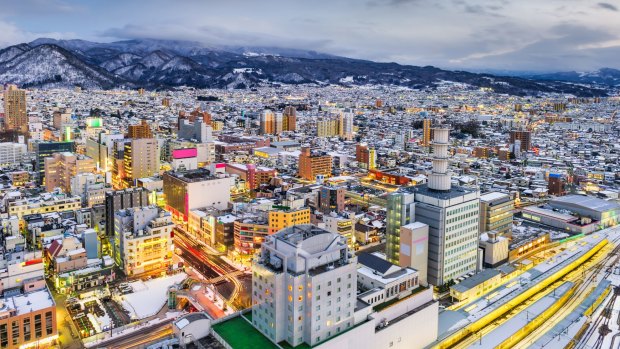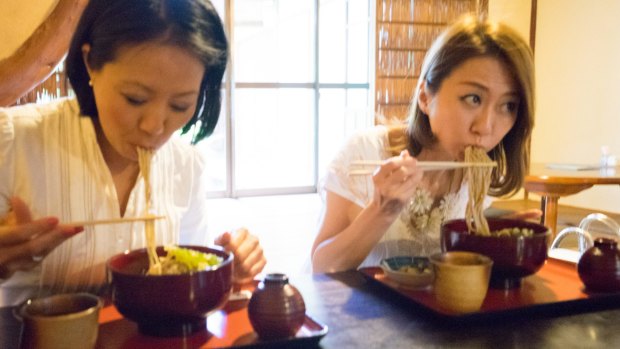This was published 4 years ago
Tohoku, Japan: The hidden world inside Japan kept secret from tourists (until now)
By Ben Groundwater

Yamagata, Japan.Credit: Sean Pavone
It takes 2466 steps to reach the sliding wooden doors of Saikan Sanrosho. Those steps meander through ancient cedar forest to the summit of a holy peak, a trail that takes pilgrims past shrines both Buddhist and Shinto, over 33 figures carved into the stone pathway, icons that bring luck to those who can find them all.
Most of the rewards for this pilgrimage are as nebulous and as intangible as the concept of luck: the chance to contemplate nature, to hear the flow of mountain streams and to see the massive trunks of centuries-old trees, to watch as their branches grasp for sunlight; to contemplate your own existence, to plod along ever upwards in a meditative state, to realise the things you, too, are grasping for, to decide if they will bring what you desire.
And then there's Saikan Sanrosho. This is a Buddhist temple at the peak of Mount Haguro, a deceptively modest building hidden among the cedars a few steps off the main path. You're not even sure you're in the right place when you approach Saikan: it's so quiet here, just the barest whisper of wind through the trees, the glow of a light visible through the wood-and-paper doors of the temple. Inside, however, it's different, a warren of narrow hallways lined with unmarked doors, the wooden floors cool to the touch of feet in socks, the cedar panels shining with the patina of 300 years of life. I'm lead through those halls by a robed monk who turns right, then left, then left again, and eventually motions to a small opening, where a low table is set up on a tatami-mat floor, a small heater the only other object in the space.

Tohoku B Gourmet Food, Japan.Credit: RoBeDeRo
That table is filled with food: 12 small dishes, delicate bowls each containing something different, something colourful, something beautiful and no doubt delicious. This is shojin ryori cuisine, the cuisine of the local Yamabushi monks, food prepared using only vegetables harvested from the mountainside, sustenance that allows pilgrims to appreciate the natural treasures of the area, that allows them to harness the power and the energy of this holy place.
It's an incredible spread. There are chrysanthemum flowers cured in vinegar; mountain yams steamed with mushrooms; eggplant grilled with miso paste; bamboo shoots lightly blanched; sesame tofu served with an umami-rich broth; mushroom stalks tossed with seeds; fresh cucumbers lightly pickled. You would climb 2466 steps for this. You would give thanks to whichever higher beings you believed in for the beauty of this meal.
Saikan Sanrosho has much in common, it turns out, with the area of Japan in which it resides. It's a hidden secret, a world within a world. It rewards those who go searching, those who aren't quite sure what they'll find.This is a huge part of Japan, a northern region that encompasses six prefectures and covers more than a quarter of Honshu, Japan's main island, and yet, what do we know about it? What do we know of Aomori and Akita, of Hirosaki and Sakata? What mind do we pay Iwaki and Kakunodate, Yokote and Tsuruoka? For most of us, very little.
And yet, there's much here to uncover.
Mount Haguro is in the Yamagata prefecture, near the rugged north-western coast of Honshu. It's a sacred area, one of three adjacent holy mountains. It's a place of pilgrimage for many Japanese travellers, though seldom seen by the outside world.
There's a five-storey wooden pagoda here that bathes in the dappled light of the cedar trees, one of which is thought to be more than 1000 years old. And there's usually no one around to see it. Tohoku in its entirety has a locals-only feel, a quality that can sometimes be charmingly quaint and beautifully peaceful with at other times, it can seem amusingly twee. There are none of the bold neon lights or the ultra-modern fashion statements of Tokyo or Osaka in Tohoku. Walk the empty streets of a town such as Sakata, on the Yamagata coast, and you see traditional, normal Japan. You see clothing stores that were probably on-trend in the '70s. You see unfussy restaurants that serve up honest, tasty fare.
One of those is Mangetsu, a ramen joint that dates back to 1920, a time when Chinese traders introduced locals to their wheat-based noodles. The Mangetsu soup is made using flying fish and kombu; the shop is filled each day with locals getting their fill, slurping up the noodles and heading back to the office. It's bustling and friendly. It's real.
Up in the Aomori prefecture, in the far north of Honshu, the attractions are similarly understated, and sometimes surprising. Here the source of local pride isn't a sports team or a musical group, but the "white impulse", a team of snow ploughs that clears the runway at Aomori Airport during winter. Thanks to "white impulse" there's never been a flight cancelled because of snow accumulation, I'm told, even in this area that receives so much of it.
Tourists don't come here for the snow ploughs though. Rather they come to visit Hirosaki, the home of Hirosaki Castle, ground zero for cherry blossom seekers when the area erupts with pinkish blooms in May. They come here for apples, too – to eat apple pie and drink apple cider. Hirosaki produces 65 per cent of Japan's apples. The post boxes here are shaped like apples. The railings around city parks have metal apples set into them. When the samurai class was disbanded here in the 1800s, many former warriors became apple farmers. Apple growing defines Hirosaki.
The legacy of the samurai lives on in Kakunodate, too, a small town in the Akita prefecture with a proud history of military nobility. This was once a castle town and stronghold of the samurai. While the castle has long since been destroyed, and the samurai relieved of their titles, the warriors' homes remain. At one, you can meet Nobu Ishiguro, a man who would have been his family's 13th generation of samurai, had the opportunity been presented. Instead he now shows visitors through his family's 200-year-old home, revealing the way the samurai once lived, showing the life of a noble warrior. It's fascinating and surprising.
There's far more to the Tohoku region, more than you could hope to fit into a short narrative, or indeed a short stay. The attractions range from the rich gastronomic traditions of Tsuruoka to the natural beauty of Lake Towada; from the luxury of five-star ryokans at Yudagawa Onsen to the character-filled Sukayu Onsen in Aomori.
All of these places are worthy of a pilgrimage, worthy of a departure from the parts of Japan that are so well known. Take a chance on somewhere different. Luck, around here, will usually be on your side.
FIVE MORE THINGS TO SEE AND DO IN TOHOKU
HAKKODA
All of that snow in the Aomori prefecture also means there's excellent skiing, and few mountains are better than Hakkoda. There's a locals-only feel here, with excellent off-piste action. See hakkoda-ski.com
KUHEE RYOKAN
There are plenty of amazing ryokans around Tohoku and this one, in Yamagata prefecture, deserves attention. The accommodation is beautiful but it's the incredible food served that sets Kuhee apart. See japanguesthouses.com
LAKE TOWADA
This area of natural beauty, in the Towada-Hachimantai National Park, is the largest crater lake in Honshu, and the perfect place to view autumn leaves during a relaxing hike. Towada is also famous for Oirase Stream, a particularly beautiful spot. See jnto.org.au
AKITA SAKE
The Akita prefecture is well known for the high quality of its sake. To get a taste for the region's best drops, call past Sake Navi, a shop in Akita city that serves every sake produced in the prefecture. See sake-navi.akita.jp
APPI KOGEN
Here's another amazing ski field with barely anyone to crowd the slopes: Appi Kogen, in Iwate prefecture. There's more infrastructure here than Hakkoda, with good nightlife and plenty to do when the weather goes bad (which means snow). See appi-japan.com
TRIP NOTES
Ben Groundwater travelled as a guest of Japan National Tourism Organization.
MORE
FLY
Qantas flies daily from east-coast ports to Tokyo, with code-share connections to Aomori, Akita and Shonai. See qantas.com
STAY
For Mount Haguro, the Kyukamura is a basic, comfortable hotel with food available on-site. See qkamura.or.jp; Saikan Sanrosho also has rooms. See japaneseguesthouses.com; In Aomori prefecture Sukayu Onsen is a hot-spring resort in the mountains. See sukayu.jp
Sign up for the Traveller Deals newsletter
Get exclusive travel deals delivered straight to your inbox. Sign up now.